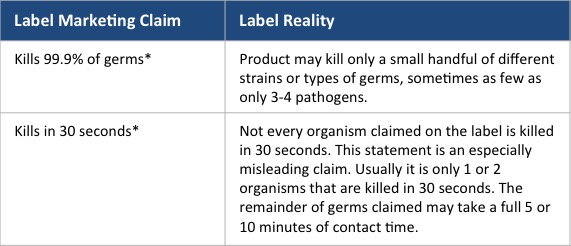Disinfecting & Sanitizing, Educational
What does the phrase “Kills 99.9% of Germs” REALLY mean?
Frankly, not much.
This type of statement and other similar ones that are used in the marketing of many common disinfectants can be misleading and potentially dangerous if it is the primary reason you are choosing a particular product.
Imagine you are concerned about the flu virus and you want to use a disinfectant that will be effective against all of this year’s Influenza types and strains. If a disinfectant claims that it will kill 99.9% of germs, it should kill 99.9% of the flu germs on a given surface, right? And, if killing 99.9% of germs is good, then a product that says it will kill 99.99% of germs should work even better, right?
WRONG. On both questions.
Some of the most popular disinfectants sold in the United States are effective on only a small number of pathogens. Many of these products have marketing statements that say the product “kills 99.9% of germs*.” However, somewhere on the container in small print is the list of germs it actually kills, and this list of germs may or may not include some or all of the Influenza viruses.
A quick look at the label of many popular products reveals some interesting facts found in the large print of marketing and the small print of reality. As a general rule of thumb, if you see an asterisk on a label then the marketing claims need a closer examination.
The Truth About 99.9%
When a marketing claim of “kills 99.9% of germs” is used, it may or may not kill the specific variety of bacteria or pathogen you need killed. By law, disinfectants must list the microorganisms which a product has been tested for and found to be effective against on their label, as well as proper dilution and directions for use. Check the label for the specific pathogens you need protection from.
All Disinfectants Are Not Created Equal
Many people think that all disinfectant solutions are basically the same and the only differences are color, fragrance, and maybe the dilution ratio. The truth is that there are many different formulations which vary primarily based on chemical composition, efficacy claims (what it is proven to kill) and dilution ratios.
Common types of disinfectants used for facility maintenance may include active ingredients such as quaternary ammonium (quat), sodium hypochlorite (bleach), hydrogen peroxide, silver ions, iodine, acids or alcohol – each of which may be effective on different strains of pathogens.
Some types of formulations are more effective against viruses such as influenza and colds. Others are effective against bacteria commonly found in and around food preparation areas. Others are considered high-level disinfectants with very a wide range of efficacy against antibiotic resistant organisms for the healthcare market. And still others have claims most useful in animal clinics. It is important to know what you need.
Disinfectants kill only select strains of germs. No disinfectant is capable of killing all germs found on a hard surface. The absence of all germs is referred to as sterilization and is a process that surpasses the efficacy level achieved with any disinfectant solution. EPA-registered chemical sterilants are the only types of sanitation products that can make a claim to kill all pathogens on hard surfaces.
Make an Informed Disinfectant Decision
Before deciding on which disinfectant is right for your specific purpose, be sure to read its label. Many excellent disinfectant solutions exist that meet the needs of most applications. When choosing, consider a few key decision-making guidelines:
What are the germs of concern?
- If it is cold or flu, chose a product with a wide range of claims against viruses
- In a health care setting antibiotic resistant bacteria and Clostridium difficile (C.diff) are present. Often hospitals and other healthcare facilities will use more than one disinfectant solution to effectively combat the different types of pathogens they are most concerned with
- Schools and daycare may have specific organisms of concern, such as RSV
- Animal care facilities need products with claims specific for animals, such as canine parvovirus or feline leukemia
Surfaces to be disinfected: Some disinfectants are not recommended for all surfaces. One example is bleach, which can be damaging to stainless steel. Another is products with a high pH, which can damage floor finishes and fabrics. Neutral pH solutions are better on floors than high pH solutions, however they may not have all of your required kill claims.
Safety and user exposure: Building occupants, students, patients, residents, and janitorial staff may have skin or odor sensitivities to various disinfectant solutions.
Dilution: Disinfectants come in concentrated, ready to use, wipes, and even aerosol forms, each with different kill claims. You’ll want to consider convenience and budget.
So what does the statement “Kills 99.9% of germs” on a disinfectant really mean? We think not much. The bottom line is that no matter what the marketing claim, no single disinfectant solution will work for every application and in every setting. Many excellent options for disinfecting are available. Read the label and consult your supplier for an appropriate recommendation.
***
TIP: On Nyco’s website, type in a pathogen name in the SEARCH bar in the upper right, then click on it in the dropdown to see disinfectants with efficacies for that specific pathogen.


